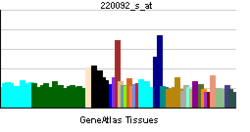ANTXR1
| View/Edit Human | View/Edit Mouse |
Anthrax toxin receptor 1 is a protein that in humans is encoded by the ANTXR1 gene.[3][4][5]
The protein encoded by this gene is a type I transmembrane protein and is a tumor-specific endothelial marker that has been implicated in colorectal cancer. This protein has been shown to also be a docking protein or receptor for Bacillus anthracis toxin, the causative agent of the disease, anthrax. The binding of the protective antigen (PA) component, of the tripartite anthrax toxin, to this receptor protein mediates delivery of toxin components to the cytosol of cells. Once inside the cell, the other two components of anthrax toxin, edema factor (EF) and lethal factor (LF) disrupt normal cellular processes. Three alternatively spliced variants have been described.[5]
See also
References
- ↑ "Human PubMed Reference:".
- ↑ "Mouse PubMed Reference:".
- ↑ St Croix B, Rago C, Velculescu V, Traverso G, Romans KE, Montgomery E, Lal A, Riggins GJ, Lengauer C, Vogelstein B, Kinzler KW (Aug 2000). "Genes expressed in human tumor endothelium". Science. 289 (5482): 1197–202. doi:10.1126/science.289.5482.1197. PMID 10947988.
- ↑ Carson-Walter EB, Watkins DN, Nanda A, Vogelstein B, Kinzler KW, St Croix B (Sep 2001). "Cell surface tumor endothelial markers are conserved in mice and humans". Cancer Res. 61 (18): 6649–55. PMID 11559528.
- 1 2 "Entrez Gene: ANTXR1 anthrax toxin receptor 1".
Further reading
- Maruyama K, Sugano S (1994). "Oligo-capping: a simple method to replace the cap structure of eukaryotic mRNAs with oligoribonucleotides". Gene. 138 (1–2): 171–4. doi:10.1016/0378-1119(94)90802-8. PMID 8125298.
- Suzuki Y, Yoshitomo-Nakagawa K, Maruyama K, et al. (1997). "Construction and characterization of a full length-enriched and a 5'-end-enriched cDNA library". Gene. 200 (1–2): 149–56. doi:10.1016/S0378-1119(97)00411-3. PMID 9373149.
- Schmidt DR, Schreiber SL (1999). "Molecular association between ATR and two components of the nucleosome remodeling and deacetylating complex, HDAC2 and CHD4". Biochemistry. 38 (44): 14711–7. doi:10.1021/bi991614n. PMID 10545197.
- Liu XH, Collier RJ, Youle RJ (2002). "Inhibition of axotomy-induced neuronal apoptosis by extracellular delivery of a Bcl-XL fusion protein". J. Biol. Chem. 276 (49): 46326–32. doi:10.1074/jbc.M108930200. PMID 11574549.
- Bradley KA, Mogridge J, Mourez M, et al. (2001). "Identification of the cellular receptor for anthrax toxin". Nature. 414 (6860): 225–9. doi:10.1038/n35101999. PMID 11700562.
- Latonen L, Taya Y, Laiho M (2001). "UV-radiation induces dose-dependent regulation of p53 response and modulates p53-HDM2 interaction in human fibroblasts". Oncogene. 20 (46): 6784–93. doi:10.1038/sj.onc.1204883. PMID 11709713.
- Strausberg RL, Feingold EA, Grouse LH, et al. (2003). "Generation and initial analysis of more than 15,000 full-length human and mouse cDNA sequences". Proc. Natl. Acad. Sci. U.S.A. 99 (26): 16899–903. doi:10.1073/pnas.242603899. PMC 139241
 . PMID 12477932.
. PMID 12477932. - Scobie HM, Rainey GJ, Bradley KA, Young JA (2003). "Human capillary morphogenesis protein 2 functions as an anthrax toxin receptor". Proc. Natl. Acad. Sci. U.S.A. 100 (9): 5170–4. doi:10.1073/pnas.0431098100. PMC 154317
 . PMID 12700348.
. PMID 12700348. - Bradley KA, Mogridge J, Jonah G, et al. (2004). "Binding of anthrax toxin to its receptor is similar to alpha integrin-ligand interactions". J. Biol. Chem. 278 (49): 49342–7. doi:10.1074/jbc.M307900200. PMID 14507921.
- Ota T, Suzuki Y, Nishikawa T, et al. (2004). "Complete sequencing and characterization of 21,243 full-length human cDNAs". Nat. Genet. 36 (1): 40–5. doi:10.1038/ng1285. PMID 14702039.
- Jones GG, Reaper PM, Pettitt AR, Sherrington PD (2004). "The ATR-p53 pathway is suppressed in noncycling normal and malignant lymphocytes". Oncogene. 23 (10): 1911–21. doi:10.1038/sj.onc.1207318. PMID 14755251.
- Hillman RT, Green RE, Brenner SE (2005). "An unappreciated role for RNA surveillance". Genome Biol. 5 (2): R8. doi:10.1186/gb-2004-5-2-r8. PMC 395752
 . PMID 14759258.
. PMID 14759258. - Gerhard DS, Wagner L, Feingold EA, et al. (2004). "The Status, Quality, and Expansion of the NIH Full-Length cDNA Project: The Mammalian Gene Collection (MGC)". Genome Res. 14 (10B): 2121–7. doi:10.1101/gr.2596504. PMC 528928
 . PMID 15489334.
. PMID 15489334. - Bonuccelli G, Sotgia F, Frank PG, et al. (2005). "ATR/TEM8 is highly expressed in epithelial cells lining Bacillus anthracis' three sites of entry: implications for the pathogenesis of anthrax infection". Am. J. Physiol., Cell Physiol. 288 (6): C1402–10. doi:10.1152/ajpcell.00582.2004. PMID 15689409.
- Hotchkiss KA, Basile CM, Spring SC, et al. (2005). "TEM8 expression stimulates endothelial cell adhesion and migration by regulating cell-matrix interactions on collagen". Exp. Cell Res. 305 (1): 133–44. doi:10.1016/j.yexcr.2004.12.025. PMID 15777794.
- Rmali KA, Puntis MC, Jiang WG (2005). "TEM-8 and tubule formation in endothelial cells, its potential role of its vW/TM domains". Biochem. Biophys. Res. Commun. 334 (1): 231–8. doi:10.1016/j.bbrc.2005.06.085. PMID 15993844.
- Rainey GJ, Wigelsworth DJ, Ryan PL, et al. (2005). "Receptor-specific requirements for anthrax toxin delivery into cells". Proc. Natl. Acad. Sci. U.S.A. 102 (37): 13278–83. doi:10.1073/pnas.0505865102. PMC 1201603
 . PMID 16141341.
. PMID 16141341. - Rual JF, Venkatesan K, Hao T, et al. (2005). "Towards a proteome-scale map of the human protein-protein interaction network". Nature. 437 (7062): 1173–8. doi:10.1038/nature04209. PMID 16189514.
